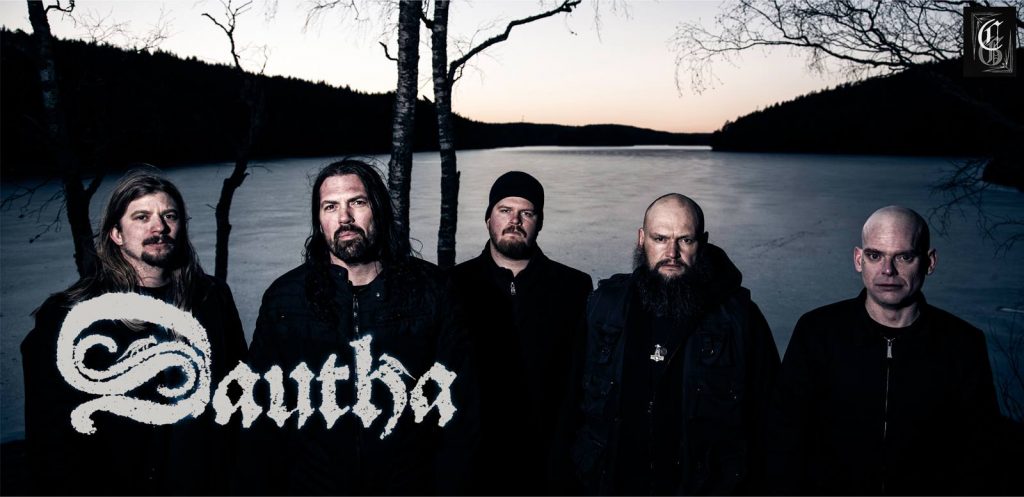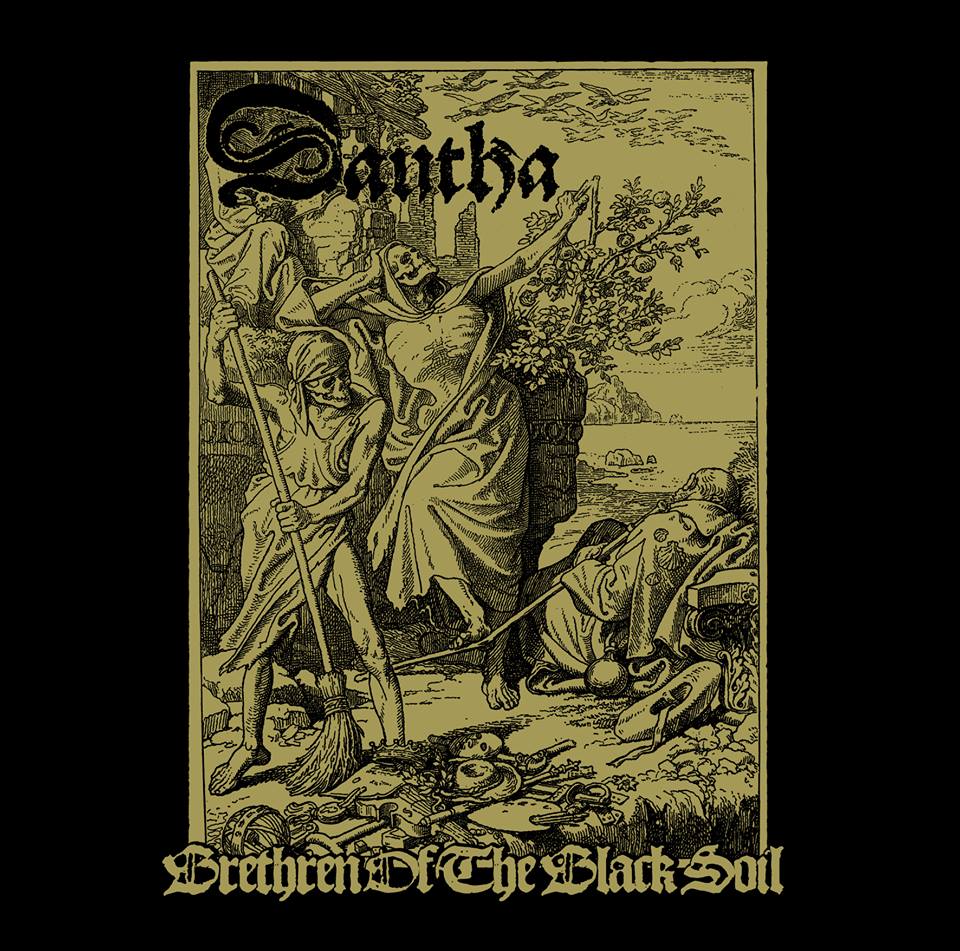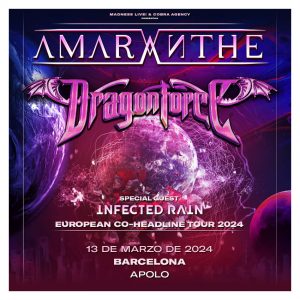DAUTHA (EN)
– Hello and first, of all, thank you for answering to our questions. How has everything been lately into the DAUTHA’s camp? How does it feel having released your debut album?
Greetings, and thank you for letting us be seen through Queens Of Steel. It has been busy of late here since the interviews started pouring in steadily a month before the release date of the album, and they keep coming in, which feels great, of course. To have the album out is a relief, and to hear from fans and reviewers that think we have succeeded in bringing our vision of Epic Doom Metal to them is very rewarding.
– The first question that would come to my mind is what lessons did you learn from the experience of releasing, writing and producing the «Den Förste» demo a couple of years back. Was it some kind of self knowing experience? A learning process?
The demo release of Den Förste involved so much more than writing, producing and releasing it since I also choose to give it the kind of packaging I thought it deserved, namely a hand crafted, patinated card board sleeve with leather spine in medieval style. It took 10 weeks, working between 5-12 hours each day, to finish 78 copies and this process gave me self knowledge all right, and what I learned was that I will not do something like that again. However, it seems I am doomed to repeat this handicraft psychosis every sixth year or so because I have done similar batches of hand made sleeves for my two earlier bands The Doomsday Cult and Griftegård also. I guess it can be seen as a compulsive ritual performed to celebrate the birth of a new vessel for my inspiration or something. As for what the writing and producing of Den Förste taught us, well…nothing revolutionary, really, just to be prepared and learn your chops before you get into the studio. For example, there was one particular riff in one of the songs that almost drove me mad because I couldn’t get it right, and time just flew. At rehearsals it felt right, sounded right, but in the studio isolated in the mix, not so very much. I nailed it eventually, but it took forever and had I practiced it enough outside the rehearsal space I would have saved the engineer and myself a heap of frustration. So for the studio recording for the album I had done my lessons and things went really smooth. Another thing we learned as a band when recording Den Förste was what kind of production we wanted to achieve for the album (and this is, of course, part of the reasons for making a demo in the first place) and Kristian Karlsson of Hufvudstaden delivered according to our vision.
– I guess the creative process behind an album involves a lot of things, also on a more personal level if you will. Now that «Brethren of the Black Soil» is done and released, could you say it somehow comes to live again or do you perceive it on a different way compared to when you were working on it and started to come up with the first song ideas for it?
The album creating process did indeed involve, and demand, a lot of things. Like me being a nuisance to my partner, and at times to my band colleges, during the most intensive writing phase. I was absent-minded at home and I came to rehearsals with new stuff all the time, or with changes of old stuff, to the point where I started to annoy the others. Birth pangs, one can say, but necessary for the end result. Also, me and Lars had to battle it out when it came to lyrics versus song melodies. I tend to write the lyrics as finished poems, and naturally I want to preserve their original charge when they are adapted to Lars’ vocal melodies (editing lyrics always hurts this author to a certain degree…), and this takes some re-writing at times, which made Lars and I spend quite a few evenings together cutting through my poetic undergrowth until we had solid hooks for all tunes. And of course we made pre-recordings of all the material as we went along, stuff that I have spent countless hours digesting during lonely car rides and in front of the pc until I found everything to be in order and ready for studio recording. Now when the dust has settled and there’s nothing more to change one has to live with the glitches, cause there are some, but I guess only those involved in the creation of the album can hear them, or at least we are the only ones that are bothered by them… Still, it is a closed chapter now, with errors and all, and that’s how I perceive it. Gone is the maniacal obsession, that most luxurious of feelings when one is totally absorbed by all aspects of creation. Now all my inspiration and madness will be directed into album number two, because this is how I live and breath, namely inside projects. Well, up till when I became a father last year that is…because this changed everything, really. A child is born, an ego dies, and that’s how it must be, amen.
– This being said, are there any finished songs that didn’t make it to the album?
There was one more song ready enough for us to seriously consider recording it for the album by the time we went into the studio. In the end we realized it would have made the album unbearably long, but rest assured it will end up on album number two.
– «Dautha» means death in ancient Swedish. How did you come up with the band name and how do you think it fits/represents the whole band itself?
An obsession of mine is the Black Death and in a Swedish book on the subject I learned that in our country during medieval times this epidemic went under the name «tihra dautha» (tihra translates to great/huge/rich/voluminous), and this was the band name for almost a year before I choose to shorten it to just Dautha. The reasons why I chose this name is, first of all, because it links us to the medieval period I find most intriguing, that of the great plague of the 14 th century, and also, and this might sound surreal, because fate had a hand in it. See, one day about five years ago I found a real medieval book in the trash. Someone had actually dumped an ancient artifact in the trash, and I of all people found it, a man obsessed with the medieval and who had just started up a medieval themed Doom band. What are the odds? Anyway, in it were 56 wood cut prints and among these I found the picture of Death, or Dautha, which we displayed on the cover of Den Förste. Seeing this magnificently sombre, yet humorous, figure I knew we had to name the band after the guy.
– You play Epic Doom and are hailing from Sweden, which has a rich Doom Metal scene. To what extent has the music from your country inspired what you are doing with Dautha?
Being a Doomster since I was fifteen Count Raven and Candlemass are part of my DNA, so they do have an influence on Dautha, however it is on a subconscious level by now, almost thirty years later. Instead I would say that I personally am more inspired by folk and neo folk music when creating the basics for our songs. Band’s like Fire+Ice, Sol Invictus, The Moon Lay Hidden Beneath A Cloud, Comus, Joculatores Upsalienses and artists such as Shirley Collins and John Fleagle influence me consciously a lot more than any Doom band does.
– Anyway you give it your own twist adding Folk elements for instance, and with lyrics dealing with medieval themes. What are some events your lyrics talk about? And when did your interest in history born?
For people to say one has an identity of ones own is, almost, the best judgment of ones art one can hope for, so thank you! As for the themes and events dealt with on the album I want to mention Hodie Mihi Cras Tibi, which is a song that moves in the same waters as the memento mori/vanitas funerary art popular during medieval post-plague times. I believe this art style to be unsurpassed still to this day in terms of morbid beauty and when it comes to portraying our inevitable decline, and this is our little stab at it. The plot for The Children’s Crusade might also be worth mentioning, due to its grand scale tragedy alone. So, the event that has gone down in history as the Peregrinatio Puerorum, or the The Children’s Crusade, took place in 1212 and was not really a children’s affair exclusively at all since among the enthusiastic small crusaders there were all manner of people with nothing to loose, like beggars, prostitutes and other outcasts. Our narrative draws from the popular version of the story though, and in it we do not mention the hookers, drinkers, losers and gamblers but focus on the children instead, because after all we are not out to lecture, but to tell gripping tales of woe. Thus, our children leave their homes in Northern France and Germany in droves, all culled by two charismatic leaders, the prophesying shepherd boys Stephen of Cloyes and Nicholas of Cologne, in a quest to take back the Holy Land from the Saracens. These masses of children (some sources say it was 7000 while others say 30000) were called Pueri by their contemporaries and it was believed, both by the Pueri themselves and the good Christian people (not including the clergy and those in power), that they would succeed in their venture by virtue of their innocence. Mighty knight’s and kings and the celestially well connected clergy had failed, but the children would do it peacefully, through love…It’s like 1968 all over again, only in 1212… Anyway, the plan is to march to Italy where, the shepherds tell their followers, God will part the sea exodus-style and let his children walk dry shod over the Mediterranean seabed. And it is in Italy our version of the story ends in catastrophe, for those that were not lost on the way there… Pueri = True Children of Doom. And when in Italy…Maximinus Thrax deals with this particular Roman emperor who rose from a very simple back ground as a farm boy to become the first of the soldier, or barrack’s, emperor’s. A true underdog that during his reign between 235-238 A.D were in constant opposition to the wealthy elite in the senate. A curious detail regarding Maximinus is that he was a real life giant, and according to contemporary sources he stood over 2,5 meter’s tall with muscle to match. Our lyrics for this song follows his career until right before he gets killed by his own much favored soldiers, leaving him triumphant, which admittedly is a breach in our campaign for misery but so be it. My interest in history began with learning biblical stories as really young, I think. And even before my teens I started reading fantasy, and from there the leap to reading historical books isn’t too long.
– But lyrics are also written on a quite poetical way. Are you also inspired by literature? What authors and books have been somehow present, maybe even in a subconscious way when writing the lyrics for «Brethren of the Black Soil»?
I would say that the book that has inspired me the most through out my whole career would actually be The Bible, and this has to do with my upbringing, which was strictly religious. I am also inspired by a bunch of Swedish authors that you might not have heard of, like Dan Andersson, Nils Ferlin, Pär Lagerkvist and Stig Dagerman. Karin Boye is another favorite. Also, if one is to return to poetry connected to The Word for a moment I must mention that I like a lot of old Swedish psalms, and one of the best psalmists is J.O.Wallin for sure. And on the subject, even though he wasn’t really a psalmist but more of a mystic and prophet, I am deeply fascinated by Emanuel Swedenborg and his work. I’m sure that these influences is at least part of the reason why I express myself the way I do in my lyrics.
– Tell us about the cover; what is it? It has a strong medieval touch also. What about the rest of the artwork of the album? Moreover for this album you signed to Ván Records, a dedicated label that always works really hard on providing beautiful, well-cared packages. How is the experience of working with them being thus far?
The cover picture is taken from a 19th century re-issue of a medieval book I found in a flea market once, and the rest of the artwork is from the same artist, K.Oertel. I would say it is Vanitas art at its most beautiful and it echoes the lyrics of the title track and Hodie Mihi Cras Tibi (as well as the general atmosphere we desired for the album) in a perfect way. Ván are (like me) perfectionists when it comes to packaging for sure, and this is one of the reasons why we wanted to work with them. I have actually known Sven for more than a decade by now and he has released all the musical adventures I have been part of, and I guess this fact alone says what is needed in terms of how I view our cooperation.
– In fact DAUTHA feels like makes a whole experience, from the lyrics to the art and music. Is this something you consciously strive for?
Great to hear that you think we are coherent! And yes, we leave nothing to chance when it comes to creating the Dautha experience. Every component of the album has been carefully weighed in to make the sum larger than its parts.
– The whole album is really beautiful, but in a really dark, depressive way. There’s a quote by Kenneth Anger that goes «I have found a definition of the Beautiful, of my own conception of the Beautiful. It is something intense and sad… I can scarcely conceive… a type of Beauty, which has nothing to do with Sorrow.» What is the DAUTHA’s conception of beauty?
Thank you, glad to hear you see beauty in our darkness. Now, our conception of beauty, as opposed to that of K.Anger’s, has everything to do with sorrow since we, in most of our songs, aim to be where sorrow and longing meet, within the domain of melancholy. However, the English word melancholy does not really translate properly to the word in Swedish which I feel give the most accurate description of the mood we strive for, namely ”vemod”. Maybe one could say that vemod is bitter sweet sorrow, but it is not completely on spot either since this kind of sorrow would be so lame it could never pass for sorrow….guess one needs to be Swedish to truly get what I am going on about.
– This being said, I would like to highlight a couple of songs, starting with «The Children’s Crusade», with its Spanish acoustic guitar and the children’s choir. How did you record the choir and came up with these different elements?
We felt it was logical to have a children’s choir to sing in Latin the same phrases the historical Pueri (the pure/children) sang when on march. The recording of «our» children took place at the municipal music school in Finspång, which is a small village situated about 30 km from where we live. Lars happens to know the teacher’s who work there and arranged so that we could go there with our equipment and make the recording. Recording the small humans was a bit challenging though since they were not used to singing in Latin so we had to go through the pronunciation quite a lot, and also they were a bit shy, which meant we had to cheer them on a bit to get proper recording levels. All in all the result became good enough for us to successfully blend the children’s voices with Richard Larsson’s and Kristian Karlson’s in the intro. The Spanish guitar you hear in the intro is of Erik Öquist’s making. He is quite skilled within the Spanish tradition and when asked by me to elaborate upon the main riff for the intro he, quite effortlessly, came up with the perfect accompaniment for the children. A curious detail is that Erik, even though 100% Swedish, grew up partly in Spain and therefore speak Spanish fluently.
– On the other hand, «Bogbodies» somehow breaks the pattern of the rest of the album, being darker and more experimental. How did it fit in the context of the album?
Indeed it is different, and I three or four different reviewers has called it the curve ball of the album, which makes me happy as I wanted it to break out from the other tracks. Still I think it fits in perfectly as the last song, having a sense of finality to it and also it lets the album end on a darker note, and there’s no other way to end a Doom album, right? Thematically it fits right in with the rest as it deals with the breathtakingly well preserved and naturally mummified corpses of pre-medieval men and women that the song is named after.
– Then the title track pretty much sums up what this album is all about. What could you comment on it?

Beginning with the theme of the song, it came to me in pieces and the process was helped by imagining what a poor serf would say to his rich landlord/oppressor when they met below after death had claimed them both through the great plague. This little affirmation method of mine made the serf speak directly to me, as if channeled. I remember one occasion in particular when this trampled man spoke a whole verse into my mind at once. It was a quite interesting experience, strange are the ways of the subconscious… And since the lyrics kept on coming and since each new part seemed to call for a continuation the song became lengthier and more Epic, until I realized it had become, what we in old Swedish would say, a true “drapa”. This means a drawn out celebratory poem, and in this case it is death’s equalizing power that is praised. The music also came piece by piece during two years at least, although at first I didn’t realize they belonged together so they were saved up in projects with different names. It was not until Lars Palmqvist took the riff’s that became the verse and the refrain and put vocals on them that it all gelled together. And the first time I heard Lars vocal melodies I realized the song would become special enough to become the title track.
– All this about «Brethren of the Black Soil» being said; how could you describe it in just 3 words?
Epic Doom Metal.
– And what are now your near-future plans?
We will go through all the material we have ready for album number two and start trying it out at rehearsals. I will also read up on the subjects I have planned to use for the lyrics. Some of the new songs are actually already sorted in this last respect and as it looks like right now at least a couple of them will be based on some quite local history. Time to dig where we stand.
– That’s all, thank you once more for answering our questions. If you want to add some final words; feel free to do it.
Thank you once again for featuring us through Queens of Steel, hope we will have reason to talk again when album number two is out!
Tania Giménez
tania@queensofsteel.com








